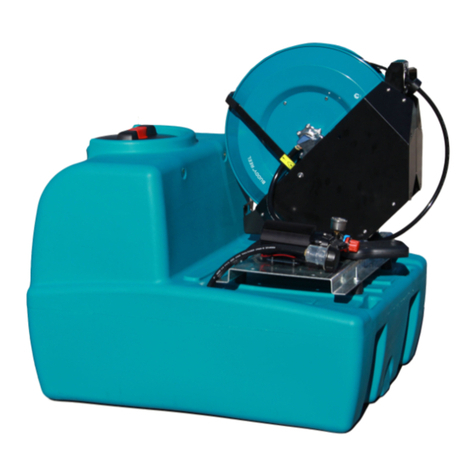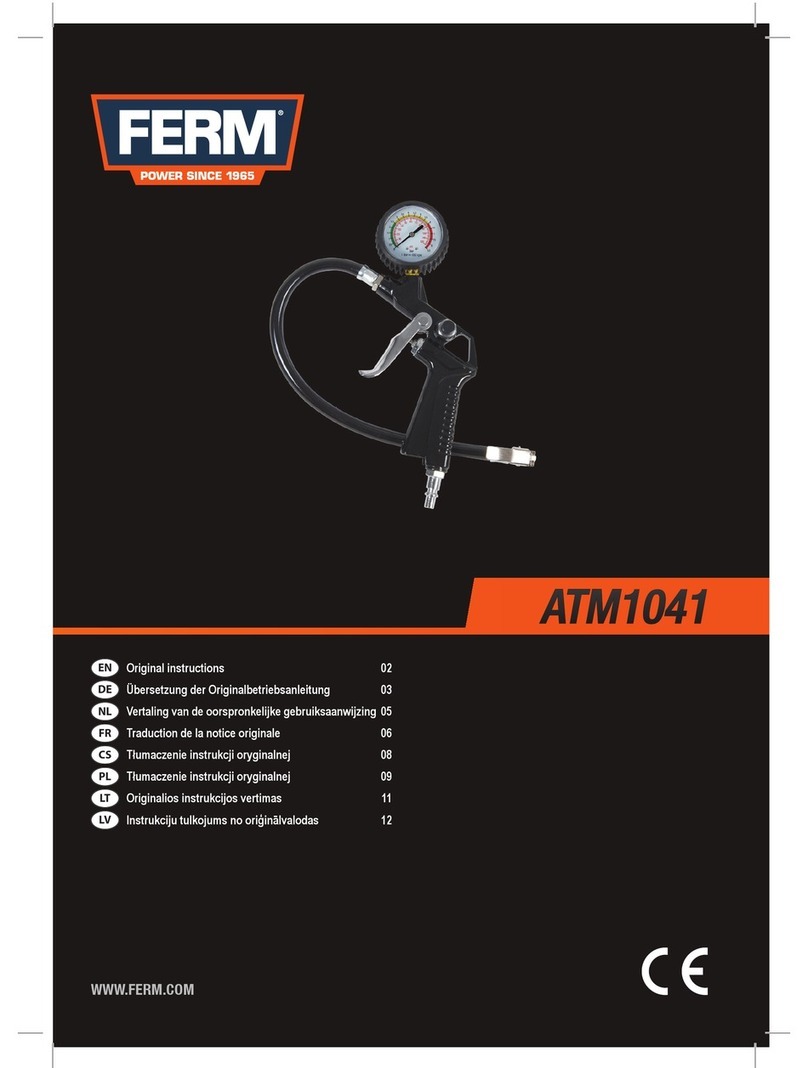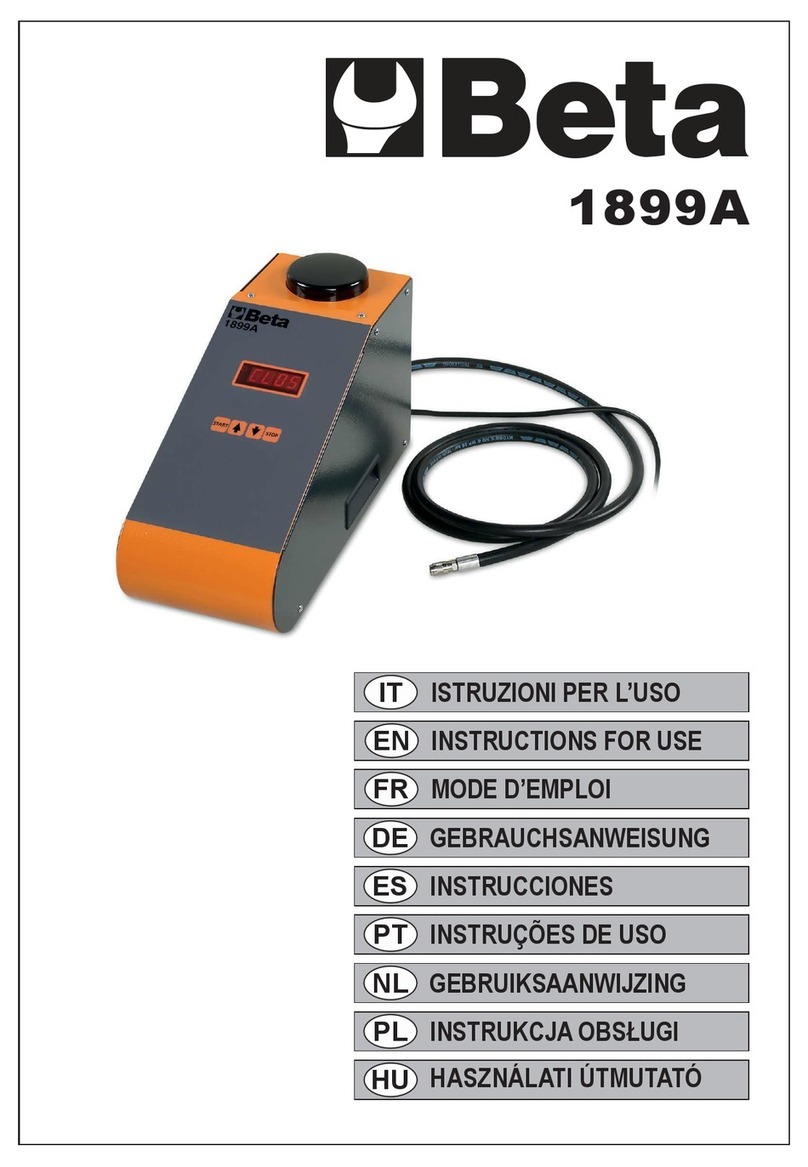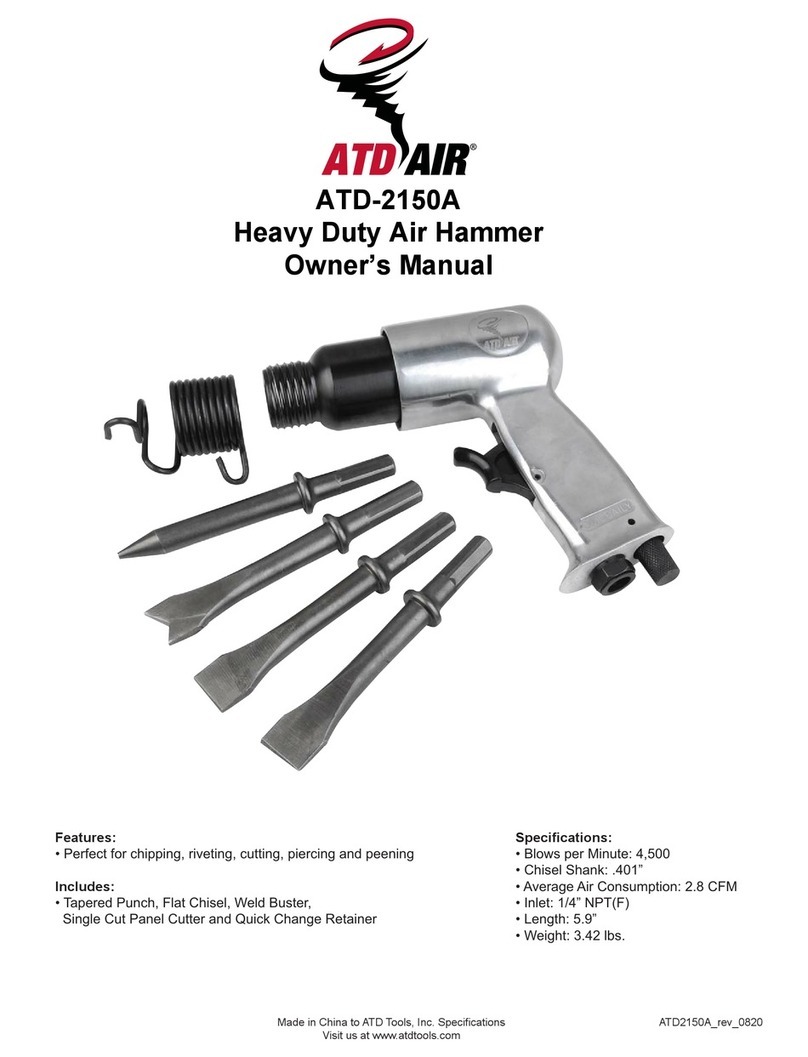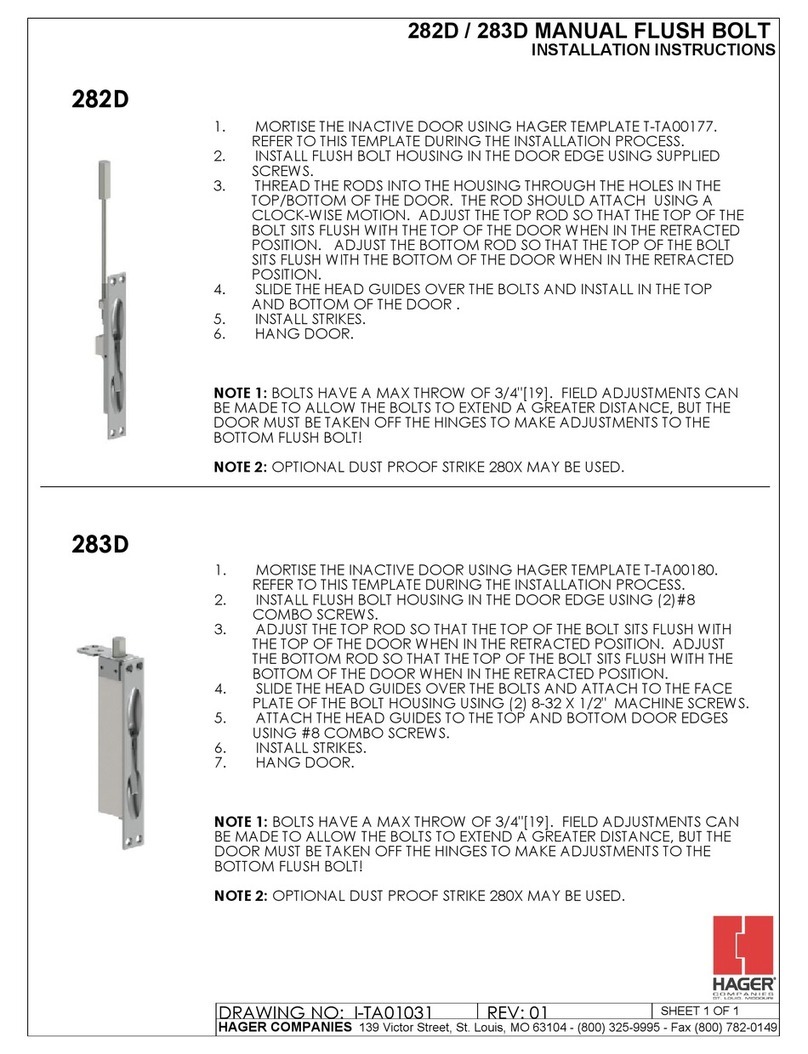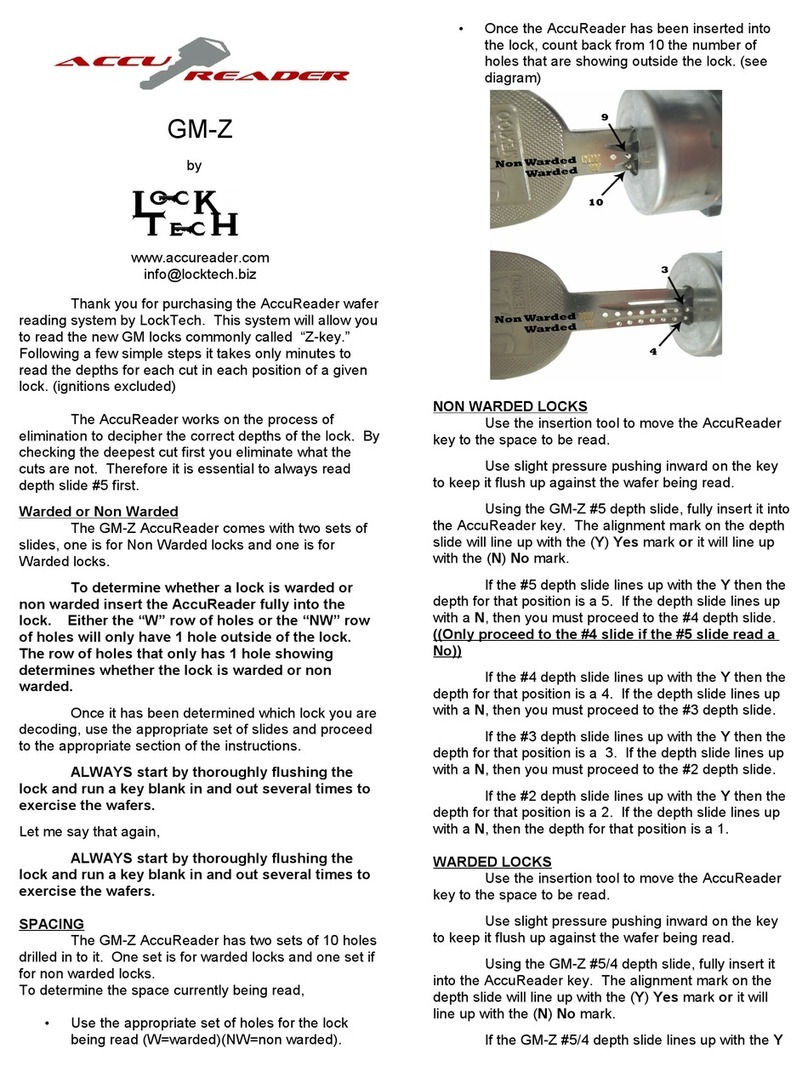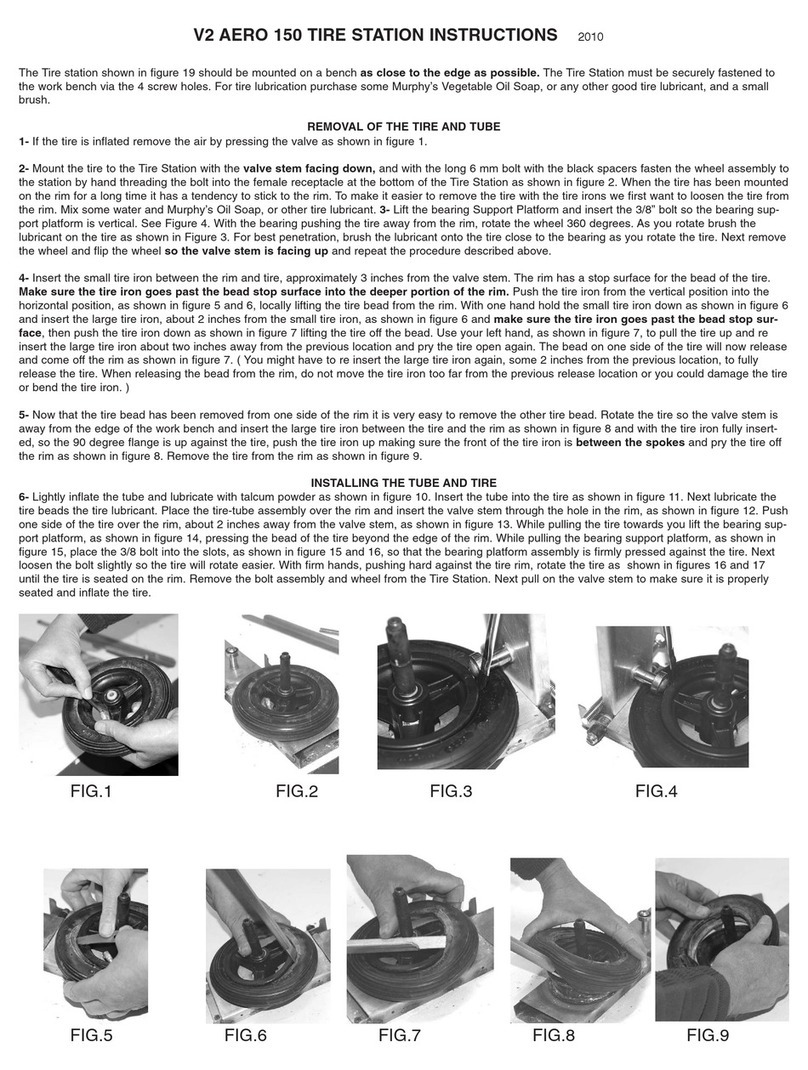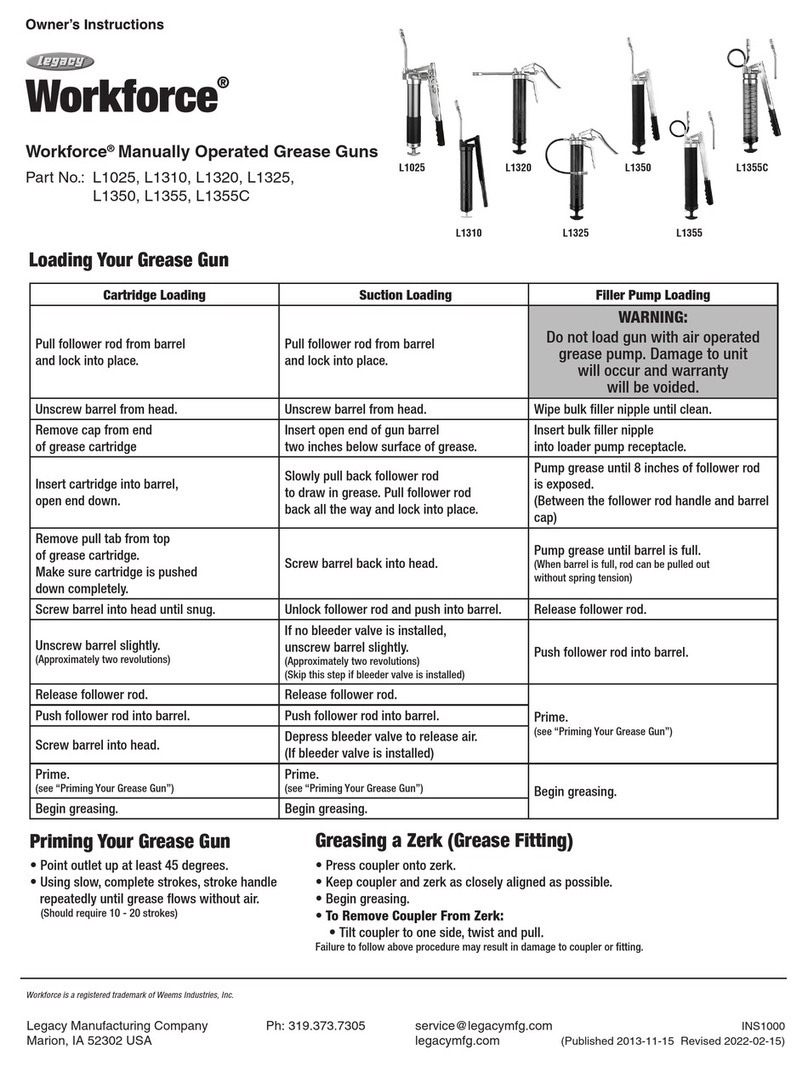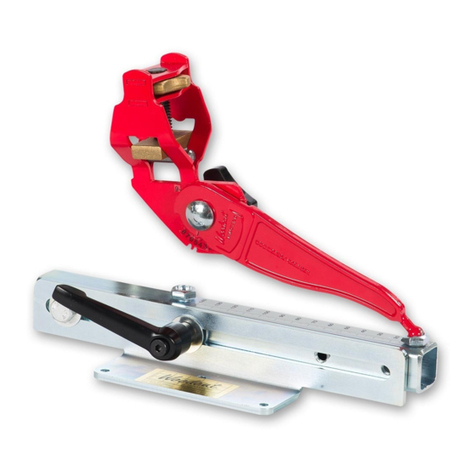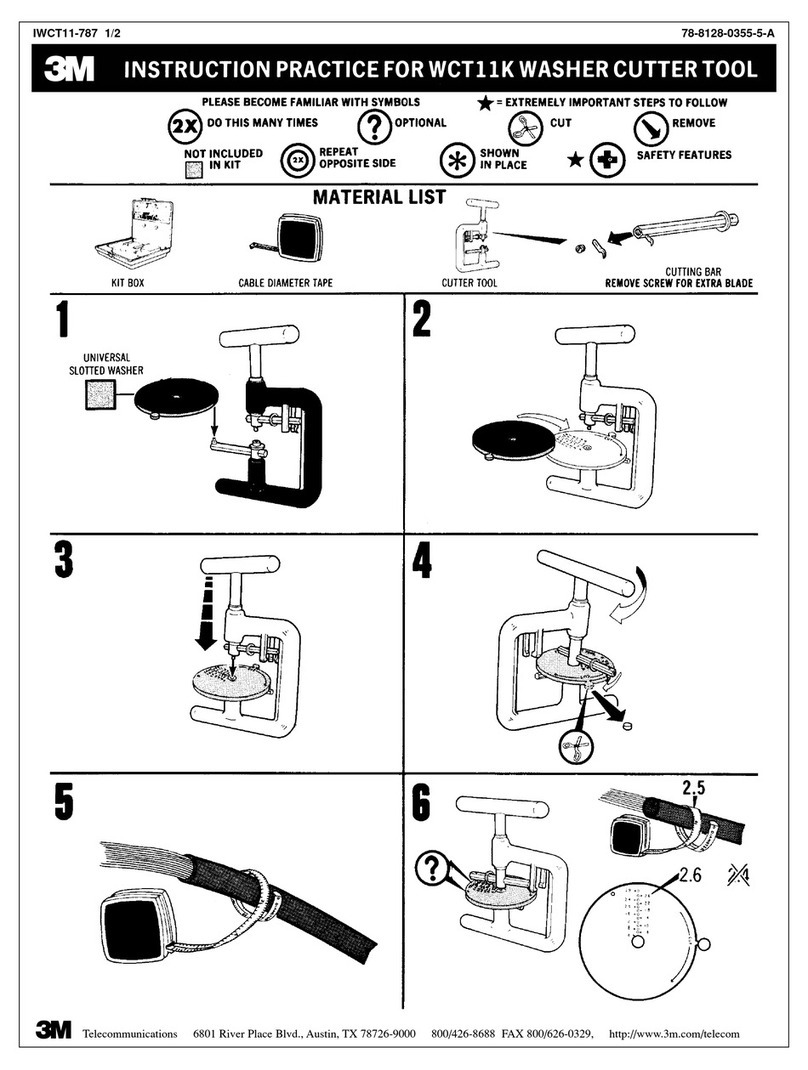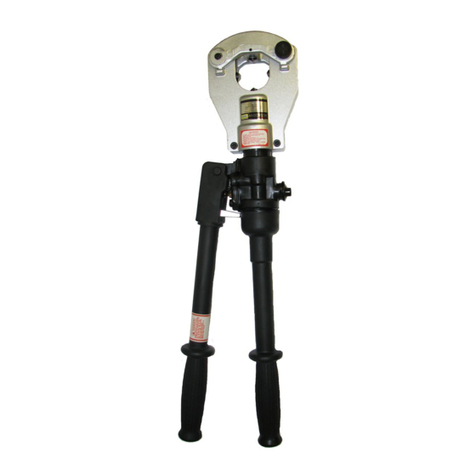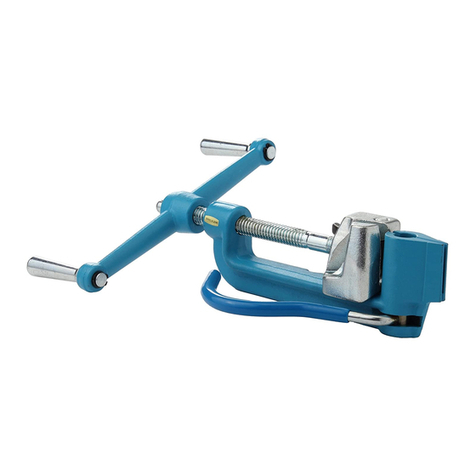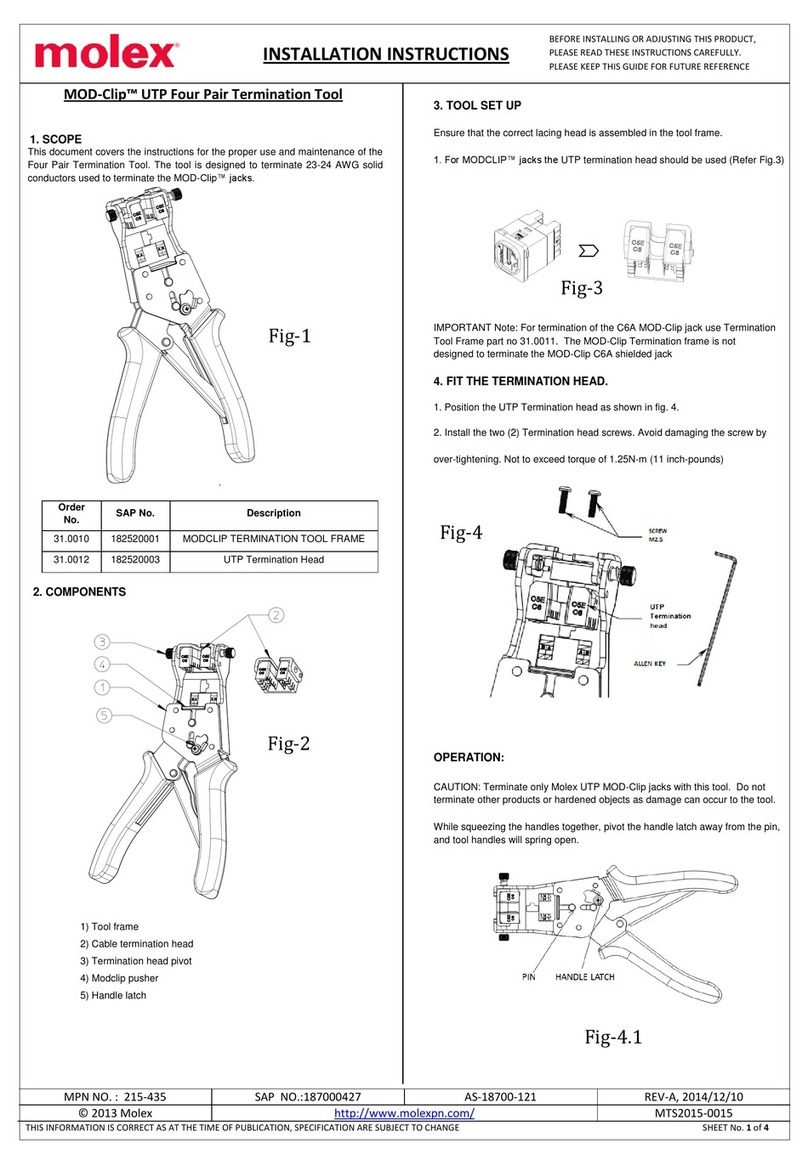PTI SENTRY TIM-100 Guide

Installation, Operation and
Serial Communication Programmer’s Guide
SENTRY™Tool Interface Module (TIM-100/120)
and Program Module (TIM-200)
Section 1: General Description &Part Names
12286 Rev 2 Page 1of 4
1.1 General Description
About This Manual
This manual is intended for those responsible for programming a computer or tool to operate with
the SENTRY process exhaust control system through the use of serial communications.
Complete instructions for installing and operating a SENTRY system may be found in the
controller’s installation and operation manual (i.e. SENTRY 1000, SENTRY 1510, etc.).
This manual describes the following:
• Physical Installation (TIM-100/120/200 Only)
• Commonly Used Command Menu Parameters
• Operation in Manual, Analog and Serial Communication Modes
• Required Programming for Using Serial Communication
Description
The SENTRY TIM-100/120 is a microprocessor-based interface used in conjunction with many of
Progressive Technologies Inc. process exhaust controllers. The SENTRY TIM-100/120 allows
the user to communicate electronically with the process exhaust controller (such as the SENTRY
1000) for changing the set point and reading actual process exhaust values. It can be configured
at the PTI factory to be used with controllers that maintain constant pressure or constant flow.
The TIM-100/120 can be operated in stand-alone mode (manual mode), with a 0-5 Volt process
tool interfaced analog signal (analog mode) or with process equipment/facility computer interfaced
serial communications (serial mode).
Two primary configurations of the TIM-100/120 are offered: 1) TIM-100 with a graphics LCD and
keypad and 2) TIM-120 which supports the analog interface and serial communications without
the LCD and keypad interface.
TIM-100 TIM-120
Note:
• The TIM-120 is pre-configured for the accompanying SENTRY system. However, a Program
Module is required if access to the command menu is required.

12286 Rev 2 Page 2of 4
1.1 General Description
Part Names and Description
SENTRY TIM-100/120
Note:
• A TIM-100 is shown above. Except for items 3 and 4, the descriptions listed also apply to the
TIM-120. Access to the display and keypad on a TIM-120 is provided through the use of a
Program Module available separately.
•• SENTRY TIM-100/120 is a
microprocessor-based interface
used in conjunction with the Sentry
exhaust controllers (SENTRY 1000,
1510, and 9000). The TIM-100/120
provides the user with the ability to
interface with the controller through
direct manual input from the user or
through electronic communication
from the process equipment.
‚‚ Mounting Brackets are used to
mount the TIM-100/120 to the
process equipment.
ƒƒ Display provides a real time
read-back of pressure control. It
also allows the user to view and
change the menu parameters.
„„ Keypad contains the four keys
used to navigate and change the
menu tree and parameters.
…… Contrast Knob allows the user to
adjust the display contrast.
†† Power/Interface Port accepts
the power cable or power and
interface cable.
‡‡ RS 422/485 Port accepts the
serial communication cable.
ˆˆ On/Off Switch is an on/off
rocker connected to a fuse. The fuse
acts as a safety cut-off device by
detecting over-current situations and
cutting power to the TIM-100/120.
‰‰ SENTRY Port accepts the TIM-
100/120 to controller cable.
ŠŠ Address Switches are used to
set the base address of the TIM-
100/120 when using the RS 422/485
port.

12286 Rev 2 Page 3of 4
1.1 General Description
SENTRY TIM-200 Program Module (Optional)
•• Program Module contains the LCD
display and keypad for use with the
TIM-120. It provides access to a TIM-
120’s command menu similar to that
found on the TIM-100. The Program
Module is used in initial set up and/or
servicing and is not required for
normal operation.
‚‚ Program Module Interface Cable
connects the Program Module with the
TIM-120. The cable plugs into a
receptacle inside the TIM-120. The TIM-120 front cover must be removed for
access to the receptacle.
Keypad (TIM-100/200)
•• Asterisk Key [*] Asterisk key
enables a menu item to be modified.
When the star key is depressed on the
keypad. An [*] will appear in the
selection indicator box (see page 8).
‚‚ & ƒƒ Up Arrow [áá] and Down
Arrow [ââ] Keys Arrow keys allow the
user to scroll through the menu items.
Once a menu item is chosen using the asterisk key, the arrow keys allow the
user to select a value or option available under the individual menu item.
„„ Enter Key [ENT] Enter key is used to enter into memory the selected menu
item that has been changed. Any change made to a menu item is only activated
after the enter key is pressed.
ROGRESSIVE
ECHNOLOGIES
P
T
NC.
I

12286 Rev 2 Page 4of 4
1.1 General Description
Display TIM-100/200
•• Selection Indicator An asterisk
symbol [*] will appear in the selection
indicator box when a menu item is
chosen by pressing the asterisk key [*]
on the keypad.
‚‚ Menu Item Name The menu item
name display indicates the current
menu item available for modification.
The user can scroll the menu by using
of the arrow keys on the keypad.
ƒƒ Exhaust Set Point The label “Pres
S” or “Flow S” on the display, indicates
whether the unit is capable of pressure
or flow set point control. The number
indicates the currently active (desired)
set point. Depending on the SENTRY
model, this value will indicate pressure
(in. H2O, mm H2O) or flow (CFM).
There may be an implied decimal point.
Refer to the controller manual for
details.
„„ Menu Item Value The menu item
value display indicates the current set
value for the menu item displayed.
…… Process Exhaust (Actual) Read-
Back The label “Pres” or “Flow ” on
the display indicates whether the read-
back is in units of pressure or flow.
The number indicates the currently
achieved (actual) process exhaust
read-back. Depending on the
SENTRY model, this value will indicate
pressure (in. H2O, mm H2O) or flow
(CFM). There may be an implied
decimal point. Refer to the controller
manual for details.
†† Graphical Display The graphical
display provides a real-time plot of the
process exhaust read-back.
‡‡ Full Scale Process Exhaust The
full-scale process exhaust indicates the
factory configured full-scale range of
the unit being operated. Depending on
the SENTRY model, this value will
indicate pressure (in. H2O, mm H2O) or
flow (CFM). There may be an implied
decimal point. Refer to the controller
manual for details.
SS
StptMode
Single
Pres
S
1700
Pres
1713
2000
0

Installation, Operation and
Serial Communication Programmer’s Guide
SENTRY™Tool Interface Module (TIM-100/120)
and Program Module (TIM-200)
Section 2: Installation & Power-Up
12286 Rev 2 Page 1of 4
2.1 Installation & Power-Up
The SENTRY TIM-100/120 is one component of the SENTRY exhaust control system. Please
follow the complete installation instructions for the specific controller.
CE Compliant Installation Note
To maintain CE compliance, if applicable, the SENTRY TIM-100/120 must be installed at a
height above the floor greater than 24” (0.6 meter).
Both the TIM-100 and TIM-120 are equipped with 4 holes for panel mounting as shown.
Power Requirements
The SENTRY TIM-100/120 operates using both positive and negative DC voltages. DC
Voltages may be supplied directly from the equipment via an interface cable or through a
stand-alone universal power supply (available from PTI).
Note:
• In case of AC over-current situations, the SENTRY system relies upon the process
equipment for AC main disconnect.
• The PTI Universal Power Supply, if used, provides additional DC short circuit current
protection with automatic reset
The DC Voltage supplies required for TIM-100/120 operation are:
1. Positive Voltage: + 15 to +24 VDC @ 650 mA
This voltage is used to power the electronic circuitry of the TIM-100/120 and
controller.

12286 Rev 2 Page 2of 4
2.1 Installation and Power-Up
2. Negative Voltage: -15 to -24 VDC @ 50 mA
This voltage is used solely to power the TIM-100/120 display.
3. Fused Circuit Protection: The TIM-100/120 has an internal fuse for over current
protection. Fuse specifications:
Size: 5 X 20 mm
Rating: 0.80 Amp
Manufacturer: PTI P/N 12270
TIM-100/120 Cabling
Cabling to the TIM-100/120 will depend upon the controller model being installed and the type
of communication interface to be used. Please refer to the controller operator’s manual for
detailed instructions on connecting the SENTRY system cabling.
Connect Program Module (If Required)
The TIM-120 is shipped pre-configured for use with the SENTRY system. The Program
Module provides keypad access and LCD readout similar to a TIM-100. The Program Module
is only required for the TIM-120 if selecting alternate communication protocols or menu
parameters.
•Remove the four screws and the faceplate from the front of the TIM-120.
‚Connect the Program Module interface cable to the receptacle on the computer board
inside the TIM-100/120. The connector is keyed and will only insert properly in one
direction.
ƒAfter use, remove the interface cable and replace the faceplate and accompanying
screws.
Power ON the SENTRY TIM-100/120
•Turn the TIM-100/120 to the ON (1) state.
‚Use the contrast knob (2) to adjust the
display.
ROGRESSIVE
ECHNOLOGIE
S
P
T
NC.

12286 Rev 2 Page 3of 4
2.1 Installation and Power-Up
Select Communication Operating Mode
The TIM-100/120 communication operating mode must be selected before set points can be
properly received and interpreted.
•Using the up [á] or down [â] arrow keys on the SENTRY
TIM-100/120 keypad, scroll through the menu parameters
until “STPT MODE” is shown in the top left corner of the
display.
‚Choose the menu item by pressing on the asterisk [*] key.
ƒUsing the up [á] or down [â] arrow keys on the SENTRY
TIM-100/120 keypad, scroll through the list and choose
“SINGLE” if using stand-alone operation or serial
(interface) communication or choose “ANALOG” if using
analog (interface) communication.
„Press the enter [ENT] key to confirm selection.
Save Operating Parameter Data
Any change made to the menu items is stored in memory until the power to the TIM-100/120 is
turned off. To permanently store selections into memory, the following steps must be taken.
•Using the up [á] or down [â] arrow keys on the SENTRY TIM-100/120 keypad, scroll
through the menu parameters until “SAVE DATA” is shown in the top left corner of
the display.
‚Choose the menu item by depressing on the asterisk [*] key.
ƒPress the down [â] arrow key once (“0” will be displayed).
„Press the up [á] arrow key seven times (“77” will be displayed).
…Press the enter [ENT] key to confirm selection.

12286 Rev 2 Page 4of 4
2.1 Installation and Power-Up
Serial Communication Tool Interface (RS-422 or Optional RS-485)
All SENTRY TIM-100/120s support an RS422/485 serial communication link for
communication with a process equipment or host computer. The TIM-100/120 can be
configured to operate using either a four-wire RS422 link (typical configuration) or a two-wire
RS485 link. This is factory set based on the configuration ordered. The communication
interface is the same regardless of which communication link is used.
For compliance with CE EMC standards when using the serial communications interface, PTI
cable P/N W020-50 should be used. The serial cable includes a ferrite core for suppression of
conducted RF energy. The user may also supply their own cable and ferrite. The ferrite core
suggested is PTI P/N #12282 with casing P/N #12283. A ferrite of equivalent specification
may be used.
RS-422 Link (Two Differential Pairs)
The RS-422 communication link uses a four wire (Tx+, Tx-, Rx+, Rx-) connection. Two wires
are used to send from the host; two wires are used to receive by the host. The serial
communication interface cable is a six-wire cable. The TIM-100/120 end of the cable is
crimped with a RJ-12, 6-pin male connector. The other end is maintained with labeled flying
leads.
Pin # Function Comment
1Rx+ Receive from host (Positive)
2Rx-Receive from host (Negative)
3gnd Ground –Not Required
4gnd Ground –Not Required
5Tx+ Transmit to host (Positive)
6Tx-Transmit to host (Negative)
RS-485 Link (Single Differential Pair)
The RS-485 communication link uses a two wire (Tx/Rx+, Tx/Rx-) connection. Two wires are
used for bi-directional data transmission. The serial communication interface cable is a six-
wire cable. The TIM-100/120 end of the cable is crimped with a RJ-12, 6-pin male connector.
The other end is maintained with labeled flying leads.
Pin # Function Comment
1Tx/Rx+ Bi-directional data (Positive)
2Tx/Rx-Bi-directional data (Negative)
3gnd Ground –Not Required
4-No connection
5-No connection
6-No connection
1 ü
2 ü
3 ý
4 ý
5 ü
6 ü
1 ü
2 ü
3 ý
4 ý
5 ý
6 ý

Operation and
Serial Communication Programmer’s Guide
SENTRY™Tool Interface Module (TIM-100/120)
and Program Module (TIM-200)
Section 3: Command Menu
12286 Rev 2 Page 1of 3
3.1 The Command Menu
The SENTRY TIM-100/120 is common to all PTI automated exhaust controllers. As such, the
TIM-100/120 contains a number of command items that may not be applicable to the specific
SENTRY system being installed. The complete menu is listed below. The menu contains 71
individual entries, 64 of which are directly accessible by the keyboard using the arrow keys. An
explanation is provided for the parameters most commonly used. These menu items are
highlighted in the menu list below.
The Complete SENTRY TIM-100/120 Command Menu
1) Sentry Ver 20) Pos Sp3 39) BaudRate 58) StepRate
2) Pres Sp 21) Pos Sp4 40) Parity 59) PulWidth
3) Flow Sp 22) Usage 1 41) HWCtlLck 60) StepRang
4) Pos Sp 23) Usage 2 42) Ctl Itvl 61) Step Lim
5) Pres 24) Usage 3 43) CtrlLock 62) Step Req
6) Flow 25) Usage 4 44) FlowCoef 63) PlotItvl
7) Step Cnt 26) Select 45) FlwCfCrs 64) PlotMode
8) HouseVac 27) Alarms 46) FiltRate 65) Plot Sel
9) Aux In 28) Dev Band 47) LookBand 66) Cycle
10) Pres Sp1 29) Lo Alarm 48) BalDelta 67) CyclItvl
11) Pres Sp2 30) Hi Alarm 49) Ctrl Inv 68) StptMode
12) Pres Sp3 31) Clk Min 50) Gain 69) OperMode
13) Pres Sp4 32) Clk Hour51) GainFine 70) CtrlMode
14) Flow Sp1 33) Clk WDay 52) Integral 71) Pos_Mode
15) Flow Sp2 34) Pres FS 53) Intg Sum 72) ResetAct
16) Flow Sp3 35) Flow FS 54) Deriv 73) Disp #0
17) Flow Sp4 36) House FS 55) Deadband 74) Disp #1
18) Pos Sp1 37) Aux FS 56) Hyster 75) Disp #2
19) Pos Sp2 38) SaveData 57) MaxCtlSt 76) "Blank"

12286 Rev 2 Page 2of 3
3.1 Command Menu
Explanation of Commonly Used Menu Entries
Reference # & Menu Item Function
9) Aux In This indicates the measured voltage from the analog input set point
control. This will reflect the voltage received at the TIM-100/120 from
the equipment (5000 = 5.000 V).
10) Pres Sp1 For pressure exhaust controllers, this entry allows the pressure set
point to be reviewed or edited. For the SENTRY 1000, 2000 = 2.000”
H2O. For the SENTRY 1510, 2540 = 25.40 mm H2O.
14) Flow Sp1 For flow exhaust controllers, this entry allows the flow set point to be
reviewed or edited.
34) Pres FS For pressure exhaust controllers, this indicates the full pressure scale
for the exhaust control device. The full scale must match the
pressure transducer inside the control device.
35) Flow FS For flow exhaust controllers, this indicates the full flow scale achiev-
able by the control device.
37) Aux FS This indicates the full scale of the analog signal input. When using a
0-5 V control signal (analog interface), this item must be set to 5000,
representing 5.000 V full scale.
38) SaveData This is used to save the TIM-100/120 configuration to nonvolatile
memory. Refer to section 2, page for instructions on saving
parameter changes.
39) BaudRate This is used to set the RS422/RS485 serial port speed rate. The
process equipment controller or host computer must use the same
baud rate. The TIM-100/120 can handle up to 9600 baud.
40) Parity This item allows the selection of the following serial data parity: Odd,
Even, One, and Zero. After changing parity, Save Data must be
executed first and then power to the TIM-100/120 must be cycled
once (On to Off to On).
51) GainFine This indicates the gain (proportional) coefficient that is used in the
PID loop This indicates the same value as the “Gain” menu item but
allows the operator a finer increment of adjustment.
55) Deadband This indicates the band on either side of the set point, within which
the process variable can move and not cause control loop action.
68) StptMode This is used to define where the controller receives its set point. The
selections are single, analog, dual and quad. Single indicates a
single digital set point from an RS422/RS485 serial connection or
manually set by the user. This set point is the value under Pres Sp1.
Analog indicates a remote set point, through a 0-5 V analog interface
.
Dual and Quad are not used.
69) OperMode This indicates the process parameter to be controlled. Pressure is
indicated by Pres, flow is indicated by Flow.

12286 Rev 2 Page 3of 3
3.1 Command Menu
Scaling Factors
As indicated previously, the TIM-100/120 display and menu items do not show a decimal point.
Depending on the controller or menu parameter in question, a decimal point is implied in the
displayed value.
SENTRY
Controller Scaling Factor Description
SENTRY 1510 Pressure set point (Pres Sp1), actual pressure read-back (Pres) and full
scale pressure (Pres FS) have an implied decimal point to the left of the
second digit (from the right). A scaling factor of 100 is used. The implied
units are in millimeters of water column.
Example: The displayed value 2540 equals 25.40 mm H2O.
SENTRY 1000 Pressure set point (Pres Sp1), actual pressure read-back (Pres) and full
scale pressure (Pres FS) have an implied decimal point to the left of the
third digit (from the right). A scaling factor of 1000 is used. The implied
units are in inches of water column.
Example: The displayed value 1150 equals 1.150” H2O.
SENTRY 9000 Flow set point (Flow Sp1), actual flow read-back (Flow) and full scale flow
(Flow FS) have an implied decimal point to the right of the first digit (from
the right). No scaling factor is used. The implied units are in cubic feet per
minute.
Example: The displayed value 12 equals 12 CFM.
Modes of Operation
The TIM-100/120 is factory configured to operate in Pressure Mode (SENTRY 1000 and
SENTRY 1510) or Flow Mode (SENTRY 9000) depending on the type of exhaust controller to
be operated.
PID Control Loop
The TIM-100/120 contains a PID closed loop algorithm for controlling the SENTRY controller
stepper motor during a set point change. All the controllers used in conjunction with the TIM-
100/120 have a patented PTI piston regulator. The piston regulator compensates for
fluctuations in facility exhaust to maintain a regulated process exhaust. The highly responsive
nature of the SENTRY controller off loads the PID algorithm such that the algorithm is only
required to change the controller set point. Once the new set point is reached, the piston in the
controller performs the corrective control.
Note:
• In most applications, only the gain function of the PID loop is used. This is preset at the factory and
does not typically require adjustment.

Operation and
Serial Communication Programmer’s Guide
SENTRY™Tool Interface Module (TIM-100/120)
and Program Module (TIM-200)
Section 4: Operation
12286 Rev 2 Page 1of 3
4.1 Operation
Manual (“SINGLE”) Mode Sentry Controller with TIM-100/120
Manual operation of the controller is accomplished by using the TIM-100/120 keypad. For the
TIM-120, access to the keypad and display requires the use of the TIM-200 program module (
see section 2 ). Use the keypad to enter changes to the menu items provided by the TIM-
100/120. Only one menu entry id required for the Sentry Controller (Manual Mode), pressure set
point “PRES SP1” or flow set point “FLOW SP1”. The remaining menu items are preset at the
factory with settings that should satisfy the control requirements of most installations. A list of
the menu parameters and an explanation of the most commonly used items is contained in
Section 3 of this manual. The default factory settings for each controller are listed in the
Appendix of the controller manual.
Using the Keypad
The keypad contains four keys used to navigate and change the menu list and parameters.
Description of the keys is located in Section 1of this manual.
Note:
• Any change made to a menu item is only activated after the enter key is depressed.
• Any change made to the menu item is only stored in memory until the next time the
TIM-100/120 is powered off and on. To permanently store values in memory, follow
the steps in Section -of this manual.
Manual Mode Pressure Set Point Changes
Follow the steps below to change the TIM-100/120 of the SENTRY 1000 or SENTRY 1510 set
point. The Sentry system is configured to measure and display pressure set points in units of
inches of water column for the SENTRY 1000 and units of millimeters of water column for the
SENTRY 1510.
•Using the up [á] or down [â] arrow keys on the SENTRY
TIM-100/120 keypad, scroll through the menu parameters
until “PRES SP1” is shown in the top left corner of the
display.
‚Choose the menu item by pressing on the star [*] key.
ƒUsing the up [á] or down [â] arrow keys on the SENTRY
TIM-100/120 keypad, change the displayed value to the
desired value.
„Press the enter [ENT] key to confirm selection.
Note:
• For the SENTRY 1000, there is an implied decimal point to the left of the third digit
(2000 = 2.000” H2O).
• For the SENTRY 1510, there is an implied decimal point to the left of the second digit
(2540 = 25.40 mm H2O).

12286 Rev 2 Page 2of 3
4.1 Operation
Manual Mode Flow Set Point Changes
Follow the steps below to change the SENTRY 9000 set point. The Sentry system is configured
to measure and display flow set points in units of cubic feet per minute.
•Using the up [á] or down [â] arrow keys on the
SENTRY TIM-100/120 keypad, scroll through
the menu parameters until “FLOW SP1” is
shown in the top left corner of the display.
‚Choose the menu item by pressing on the star
[*] key.
ƒUsing the up [á] or down [â] arrow keys on the
SENTRY TIM-100/120 keypad, change the
displayed value to the desired value.
„Press the enter [ENT] key to confirm selection.
Note:
• For the SENTRY 9000, a displayed value of 35 = 35 CFM.
Analog Interfaced Operation
When the SENTRY system is configured for analog operation, the process exhaust pressure or
flow set points are entered through the process equipment. The analog interface operates on a
standard 0 to 5-volt full-scale command signal.
Note:
• The menu item “STPTMODE” must be set to “ANALOG” in order to use analog
communication. Refer to Section 2, page3 for details.
• The menu item “AUX IN” will reflect the voltage received at the SENTRY TIM-100/120.
There is an implied decimal point to the left of the third digit (5000 = 5.000 volts).
• The voltage indicated by the “AUX IN” should be within ±.02 volts of the analog voltage
signal transmitted by the process tool.
• Both the analog ground and power ground leads must be connected to the TIM-
100/120 and be common on the process tool.
The following table illustrates how the set point and read-back analog voltage signals are
interpreted within the TIM-100/120.

12286 Rev 2 Page 3of 3
4.1 Operation
SENTRY 1000, SENTRY 1510 SENTRY 9000
Process exhaust pressure set point:The set
point voltage transmitted from the tool to the
SENTRY TIM-100/120 will be converted to a
pressure set point using the following equation:
PresSp Aux In
Aux FS PresFS
= ×
Process exhaust pressure read-back: The
read-back voltage returned by the SENTRY TIM-
100/120 to the equipment is proportional to the
actual measured pressure determined by the
following equation:
Measured Process Exhaust Pressure =
Pres
Pres FS Aux FS×
Process exhaust flow set point:The set
point voltage transmitted from the tool to the
SENTRY TIM-100/120 will be converted to a
flow set point using the following equation:
FlowSp AuxIn
AuxFS FlowFS= ×
Process exhaust flow read-back: The
read-back voltage returned by the SENTRY
TIM-100/120 to the tool is proportional to the
actual measured flow determined by the
following equation:
Measured Process Exhaust Flow =
Flow
Flow FS Aux FS×
Serial Interfaced Operation
When the SENTRY system is configured for serial communicationoperation, the process
exhaust pressure or flow set points are entered through the process equipment. The serial
interface operates on standard RS422/485 serial communication protocol. Process Equipment or
host programming of interrogation commands is required in order to operate in serial
communication mode. For complete interface instructions, refer to section 5.
Note:
•The menu item “STPTMODE” must be set to “SINGLE” in order to use serial communication.
Refer to Section 2, page 3 for details.
•The menu items “BAUD RATE” and “PARITY” must reflect the process tool baud rate and parity in
order to use serial communication.

Operation and
Serial Communication Programmer’s Guide
SENTRY™Tool Interface Module (TIM-100/120)
and Program Module (TIM-200)
Section 5: Serial Communication Interface Programming
12286 Rev 2 Page 1of 5
5.1 Serial Communication Interface Programming
In order to configure equipment or host to communicate with the TIM-100/120 for adjusting a
set point or interrogating a read-back value, the equipment or computer must be programmed
to communicate with the TIM-100/120.
Only three commands are required for serial communication. They are: 1) power-up clear, 2)
exhaust (pressure or flow) set point and 3) actual exhaust (pressure or flow) read-back. This
section describes the communication commands, format and protocol required to allow the
equipment or computer to adjust the set point and report a read-back through serial
communication.
General Description
A message format and communication protocol has been established for transmitting
commands and receiving acknowledgments from the TIM-100/120. The host processor and
the TIM-100/120 have a master and slave relationship, respectively. That is, the host
processor (master) is responsible for initiating communications with the TIM-100/120 (slave).
The communication protocol requires the host to send a command to the TIM-100/120. For
each command sent, the TIM-100/120 will respond with an acknowledgment message. The
communicated commands and acknowledgments are text strings made up of characters from
the ASCII character set.
Note:
• Up to 64 uniquely addressable TIM-100/120s can be connected on a given network.
• Specification guidelines for RS485 provide for a maximum of 32 units, including the host,
on a single network. A repeater is required to add additional 32 units for a maximum
total of 64 SENTRY TIM-100/120s.
• Refer to Appendix B for the serial communication specifications.
Command Description
The SENTRY Command messages consist of the following components. For a given
command, some or all of the components may be used.
• Start of message character “>”
• TIM-100/120 address and data bank
• Single character command
• Hexadecimal represented data
• Two character checksum
• Carriage return “↵”
Note:
• The TIM-100/120 uses the hexadecimal numbering system to represent numbers in
commands and responses. SENTRY command messages are transmitted as a series
of ASCII characters. Numbers are transmitted as the ASCII number characters 0
through 9 and the upper case ASCII characters A through F.
• Appendix E provides a decimal to hex and decimal to binary conversion table.

12286 Rev 2 Page 2of 5
5.1 Serial Communication Interface Programming
Start of message
Address of controller to
receive the message
Command
Command qualifiers [position] and [data]
Check sum
>
End of message
↵
Beginning Middle End
Power-Up Clear Using Command “A”
Once power has been applied to the TIM-100/120, a power-up clear command is required to
initialize communications between the host and the TIM-100/120. This command only
functions if it is the first command sent after power-up and prevents the TIM-100/120 from
returning a “power-up clear expected” error.
Note:
• This command has no effect on the TIM-100/120 operation.
• After a power up clear command is issued, the TIM-100/120 resets to the last
saved menu parameter settings.
Host to TIM-100/120 Command Message: >00AA1↵
Function: This message sends a power-up clear command to the TIM-100/120 at base
address 00 (>00AA1↵).
Note:
• If additional TIM-100/120s were connected on the same network, each base address
would be incremented by four. Example: >04AA1↵, >08AA1↵, >0CAA1↵, etc.
TIM-100/120 to Host Response: >A↵
Function: This response indicates an acknowledgement without error.
Set Point Using Command “S”
A set point command must be sent to the TIM-100/120 in order to command the process
exhaust controller to a new set point. Depending on whether the exhaust controller is a
pressure or flow controller, one of two memory locations must be addressed for this command.
A mask is used to define the memory location.
Note:
• A set point or read-back can be resolved to a 12-bit value (0 to 212 -1) with hexadecimal
representation of 000 to FFF (0 to 4095 decimal). The value is scaled relative to full-
scale pressure or full-scale flow.

12286 Rev 2 Page 3of 5
5.1 Serial Communication Interface Programming
Pressure Set Point:
In order to write a pressure set point to the TIM-100/120, the following command must be
issued:
Host to TIM-100/120 Command Message: >01S0100xxxyy↵
Where: xxx = 000 to FFF representing a 0 to full scale range
yy = two hex character check sum
Function: This message sends a set point to a SENTRY TIM-100/120 configured for
pressure control (i.e. SENTRY 1000 or SENTRY 1510).
Example: For a SENTRY 1000 with a 2” H2O (50.8 mm H2O) full-scale range,
>01S010099A28↵changes the set point to 1.2” H2O (Hex 99A based on 2”
H2O = Hex FFF).
Note:
• The SENTRY TIM-100/120 addressed is at base address 0, memory bank 1
(>01S0100xxxyy↵).
• Memory location “0100” (Pres Sp1) is being modified (>01S0100xxxyy↵).
• If additional TIM-100/120s were connected on the same network, each base address
would be incremented by four.
Example: >05S0100xxxyy↵
Flow Set Point
In order to write a flow set point to the TIM-100/120, the following command must be issued:
Host to TIM-100/120 Command Message: >01S1000xxxyy↵
Where: xxx = 000 to FFF representing a 0 to full scale range
yy = two hex character check sum
Function: This message sends a set point to a SENTRY TIM-100/120 configured for
flow control (i.e. SENTRY 9000).
Example: For a SENTRY 9000 with a 35 CFM (990 LPM) full-scale range,
>01S100099A28↵changes the set point to 21 CFM (590 LPM) (Hex 99A
based on 35 CFM = Hex FFF).
Note:
• The SENTRY TIM-100/120 addressed is at base address 0, memory bank 1
(>01S1000xxxyy↵).
• Memory location “1000” (Flow Sp1) is being modified (>01S1000xxxyy↵).
• If additional TIM-100/120s were connected on the same network, each base address
would be incremented by four.
Example: >05S1000xxxyy↵

12286 Rev 2 Page 4of 5
5.1 Serial Communication Interface Programming
TIM-100/120 Normal Acknowledgment
For both pressure and flow set point commands, the TIM-100/120 responds with the following
acknowledgment.
TIM-100/120 to Host Response: >A↵
Function: This response indicates an acknowledgement without error.
Note:
• Refer to Appendix C for error response codes.
Actual Read-Back Using Command “L”
A read-back command (interrogation) must be sent to the SENTRY TIM-100/120 in order to
request the actual process exhaust value. Depending on whether the exhaust controller is a
pressure or flow controller, one of two memory locations must be addressed for this command.
A mask is used to define the memory location.
Pressure Read-Back
In order to read the current pressure, the following command must be issued to the TIM-
100/120:
Host to TIM-100/120 Command Message: >01L00016E↵
Function: This message sends an interrogation to read the SENTRY TIM-100/120
pressure read-back memory location. The TIM-100/120 must be configured
for pressure control (i.e. SENTRY 1000 or SENTRY 1510).
Note:
• The SENTRY TIM-100/120 addressed is at base address 0, memory bank 1
(>01S00016E↵).
• A report on memory location “0001” (Pres) is being requested (>01S00016E↵).
Flow Read-Back
In order to read the current flow, the following command must be issued to the TIM-100/120:
Host to TIM-100/120 Command Message: >01L00026F↵
Function: This message sends an interrogation to read the SENTRY TIM-100/120 flow
read-back memory location. The TIM-100/120 must be configured for flow
control (i.e. SENTRY 9000).
Note:
• The SENTRY TIM-100/120 addressed is at base address 0, memory bank 1
(>01S00026F↵).
• A report on memory location “0002” (Flow) is being requested (>01S00026F↵).

12286 Rev 2 Page 5of 5
5.1 Serial Communication Interface Programming
TIM-100/120 Normal Acknowledgment
For both pressure and flow set point commands, the TIM-100/120 responds with the following
acknowledgment.
TIM-100/120 to Host Response: >A1xxxyy↵
Where: xxx = 000 to FFF representing a 0 to full scale range
yy = two hex character check sum
Function: This response indicates an acknowledgement with data but without error.
TIM-100/120 Error Response
An error response begins with the character “N” followed by the error code and carriage return
“↵”. It does not require a checksum. Error codes are listed in Appendix C.
Calculating End of Message Checksum
All command messages end with two ASCII-hex digits representing the message checksum,
followed by a carriage return. The checksum is computed by (a) adding the decimal values of
all the ASCII characters in the message, excluding the start of command character, ">", (b)
dividing the sum by 256 and (c) converting the integer remainder to a two ASCII-hex digits.
Example: •Command: >08K012
‚Ignore the ">" character
ƒConvert the remaining characters to decimal values
Character Hex Value
Decimal Value
030 48
838 56
K4B 75
030 48
131 49
232 50
SUM 146 326
„Divide the sum by 256: 326/256 = 1 remainder 70
…Convert the remainder to a two ASCII-hex digits:
70 decimal = 46 hex
Note:
• Notice that 46 are only the last two digits in the hex sum.
• Therefore, the checksum in this example is 46.
†The complete command is written as: >08K01246↵
Note:
• Although not recommended, the checksum can be replaced by the
wildcard symbol “??”.The use of the wildcard symbol does not verify the
message integrity.

Operation and
Serial Communication Programmer’s Guide
SENTRY™Tool Interface Module (TIM-100/120)
and Program Module (TIM-200)
Section 6: Troubleshooting, Specifications, Codes &
Conversion Tables
12286 Rev 2 Page 1of 6
6.1 Maintenance & Troubleshooting
Maintenance
No preventive maintenance is required to ensure that the SENTRY TIM-100/120 is in proper
working order.
Troubleshooting
The following troubleshooting table will assist the user in identifying and correcting some of the
most common problems. Refer to the controller’s installation and operation manual for a
complete guide.
Problem Possible Cause Corrective Action
(Tool Interfaced) Analog
ground and power ground
not connected or common
Connect both analog ground and power
ground. Verify that they are common on the
tool.
Set point read-
back is always
zero TIM-100/120 parameters
incorrectly configured Ensure proper parameters are selected for
the controller installed.
TIM-100/120 parameter
“STPT MODE” improperly
set for installation
Set TIM-100/120 parameter to “Analog” for
analog communication or “Single” for stand-
alone or serial communication.
(Analog Interface)
Analog interface
improperly installed
Properly install analog interface cable.
(Serial Interface)
Serial cable improperly
installed or address not
set
Properly install communication cable. Adjust
TIM-100/120 hex code to match tool settings.
All set points not
being achieved or
cannot change
set point
TIM-100/120 parameters
incorrectly configured Ensure proper parameters are selected for
the model installed.
Power not supplied Connect power.
Both positive and
negative voltage lines not
supplied
The negative voltage (-15 to -24 V @ 50 mA)
powers the display. Supply voltage
according to the appropriate cable drawing in
the Drawings section at the end of the
manual set.
Contrast not adjusted
Adjust contrast using contrast knob.
TIM-100/120
display not on
Blown Fuse
Disconnect power and remove front panel.
Replace fuse if necessary.
This manual suits for next models
2
Table of contents
